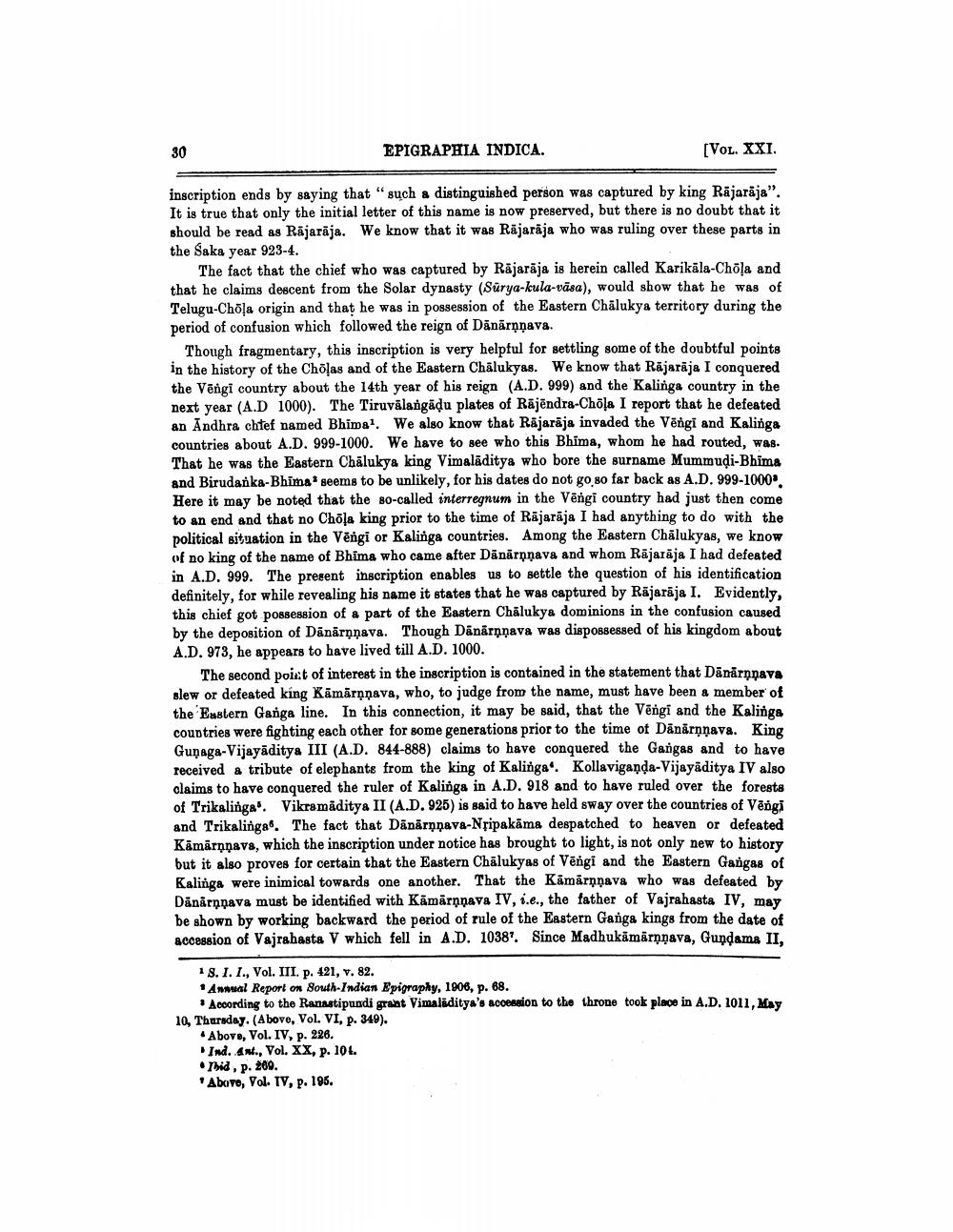________________
EPIGRAPHIA INDICA.
[Vol. XXI.
inscription ends by saying that "such a distinguished person was captured by king Rājarāja". It is true that only the initial letter of this name is now preserved, but there is no doubt that it should be read as Rajaraja. We know that it was Rājaraja who was ruling over these parts in the Saka year 923-4.
The fact that the chief who was captured by Rajarāja is herein called Karikāla-Chola and that he claims descent from the Solar dynasty (Sürya-kula-vāsa), would show that he was of Telugu-Chöļa origin and that he was in possession of the Eastern Chalukya territory during the period of confusion which followed the reign of Dānärnnava.
Though fragmentary, this inscription is very helpful for settling some of the doubtful points in the history of the Cholas and of the Eastern Chalukyas. We know that Rajarāja I conquered the Vēngi country about the 14th year of his reign (A.D. 999) and the Kalinga country in the next year (A.D 1000). The Tiruvālangādu plates of Rajendra-Chola I report that he defeated an Andhra chtef named Bhimal. We also know that Rajaraja invaded the Vëngi and Kalinga countries about A.D. 999-1000. We have to see who this Bhima, whom he had routed, was. That he was the Eastern Chalukya king Vimalāditya who bore the surname Mummudi-Bhima and Birudanka-Bhima' seems to be unlikely, for his dates do not go so far back as A.D. 999-1000 Here it may be noted that the so-called interregnum in the Vēngi country had just then come to an end and that no Chola king prior to the time of Räjarāja I had anything to do with the political situation in the Véngi or Kalinga countries. Among the Eastern Chalukyas, we know of no king of the name of Bhima who came after Dānārņnava and whom Rajaraja I had defeated in A.D. 999. The present inscription enables us to settle the question of his identification definitely, for while revealing his name it states that he was captured by Räjarāja I. Evidently, this chief got possession of a part of the Eastern Chalukya dominions in the confusion caused by the deposition of Dānārņnava. Though Dānārņņava was dispossessed of his kingdom about A.D. 973, he appears to have lived till A.D. 1000.
The second poict of interest in the inscription is contained in the statement that Dänardava slew or defeated king Kämārņnava, who, to judge from the name, must have been a member of the Eastern Ganga line. In this connection, it may be said, that the Vēngi and the Kalinga countries were fighting each other for some generations prior to the time of Dänārņnava. King Gunaga-Vijayaditya III (A.D. 844-888) claims to have conquered the Gangas and to have received a tribute of elephants from the king of Kalinga“. Kollaviganda-Vijayāditya IV also claims to have conquered the ruler of Kalinga in A.D. 918 and to have ruled over the forests of Trikalinga' Vikramaditya II (A.D. 925) is said to have held sway over the countries of Vēngi and Trikalinga. The fact that Dānārnnava-Nripakāma despatched to heaven or defeated Kämarnnava, which the inscription under notice has brought to light, is not only new to history but it also proves for certain that the Eastern Chālukyas of Vēngi and the Eastern Gangas of Kalinga were inimical towards one another. That the Kāmārņnava who was defeated by Dånarnpava must be identified with Kämärņnava IV, i.e., the father of Vajrahasta IV, may be shown by working backward the period of rule of the Eastern Ganga kings from the date of accession of Vajrahasta V which fell in A.D. 10387. Since Madhukamārnnava, Gundama II,
18.1. 1., Vol. III. p. 421, v. 82. * Annual Report on South Indian Epigraphy, 1908, p. 68.
. According to the Ranastipundi grant Vimaliditya's accension to the throne took place in A.D. 1011, May 10, Thursday. (Above, Vol. VI, p. 349).
Above, Vol. IV, p. 226. Ind. ant., Vol. XX, p. 104. Thid, p. 280. *Aboro, Vol. IV, p. 195.




